H3C Smart Campus Solution for Colleges and Universities
1. Background
In 2018, the Ministry of Education of PRC issued Action Plan for the Education Informationization 2.0, putting forward the development goals and related action plans. In the same year, the national standard document "General Framework of Smart Campus" was released, which standardized the overall architecture and basic requirements of the smart campus. The documents clarify the trend of smart campuses, and also indicate that the transformation and upgrade of informationization is a necessity for promoting education reform and an inevitable choice for the development of the times.
In consideration of the policy documents and the expectations of faculties and students for smart campuses in universities, special attention needs to be paid to the following issues during the construction:
1.1 The smart campus lacks a top-level design. Informationization fails to play a leading role in service development. Personnel training, scientific research, management services, Party building and other sectors are short of deep coordination and planning.
1.2 The informationization is in an incomplete condition, and the infrastructure and supporting platforms need to be enhanced.
1.3 The service system is isolated, and data silos still exist. The data availability ratio is low, restricting the construction of smart campus applications.
1.4 Smart applications are insufficient in educational governance, services, teaching, and environments. Teachers and students are less involved in informationization. The misalignment between the construction content and actual demands results in a poor experience or no sense of gain for teachers and students.
2. Solution overview
H3C provides an overall solution based on "4+N" for the smart campus, helping colleges and universities build the infrastructure with "comprehensive perception, unified integration, openness and sharing", a service capability platform with "integrated standard, agility and efficiency, and various models", and a smart application system with "full integration and combination, and flexibility and rapidness". The meanings of 4 and N in the solution are as follows:
"4": contains digital infrastructure, cloud and intelligent platforms, active campus security, and campus unified O&M.
"N": refers to multiple smart applications in the education industry for education governance, teaching, services, and environments.
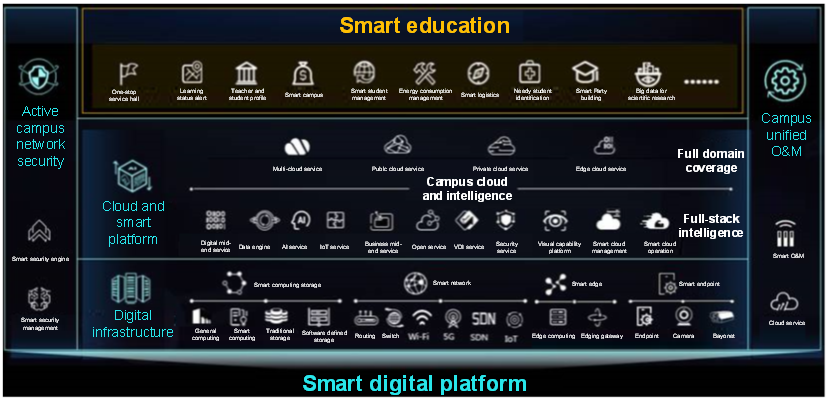
3. Solution highlights
3.1 Professional informationization top-level planning and consultation
H3C informationization top-level planning and consultation are based on the campus development strategy. Together with the campus, H3C collects the demands of service departments, sorts out the service development plan, introduces the international professional architecture methodology TOGAF, and analyzes the current situation of informationization development to form the overall design of the smart campus for coordinating the planning in personnel training, scientific research, management services, and Party building. The overall design always focuses on accurate positioning of objects, structure optimization, function coordination, and resource integration to steadily promote the smart campus construction.
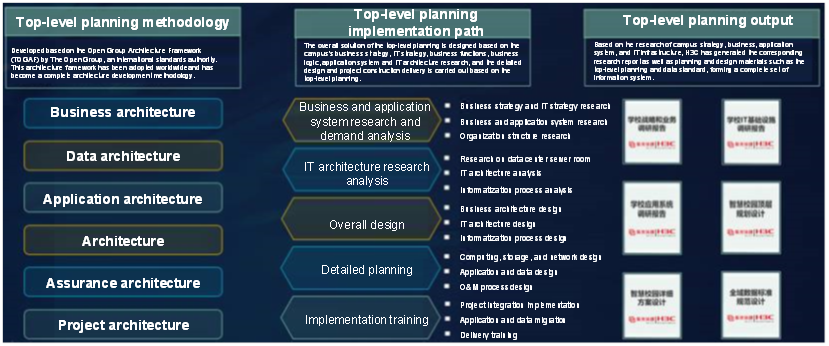
Top-level planning process
3.2 Solid smart campus base
The smart campus base consists of the campus digital infrastructure, campus cloud, and intelligent platform.
For the digital infrastructure, H3C provides the AD-Campus solution to help build “one network” for convergence of four networks, including the wired campus network, high-performance Wi-Fi 6 wireless network, IoT with compatibility across full protocols, and 5G campus network.
For the campus cloud and intelligent platform, H3C provides the campus cloud solution with the IaaS (basic resource services), PaaS (platform services such as containers and micro-services), DaaS (data services), and AIaaS (AI services).
3.3 Data mid-end and service mid-end
Data is one of the major informationization assets for colleges and universities. H3C smart campus solution provides the "dual mid-end" construction capability of the data center and service center, helping colleges and universities achieve full-scenario data governance, promote data sharing, and create data values.
The data mid-end is based on a digital intelligent engine and a capability open platform.
The digital intelligent engine enables the whole process of data processing from data integration, standard management, quality management, data development, and asset management. The digital intelligent engine boasts eight core advantages, including real-time data collection, data standard planning, one-stop data opening, self-defined data inspection, unified data asset management, unified platform entry, unified task scheduling, and micro-service architecture.
The capability open platform enables the connection between the upper-layer application and the underlying system. It provides services to the upper-layer application through APIs, data packages, and service models, reduces the difficulty of data application development, and implements service reuse and precipitation. The capability open platform has the core advantages, including "zero coding" service launch, API security management, and "draggable" service orchestration.
Through the practice of multiple smart campus cases and deep exploration of service scenarios, H3C's service mid-end has obtained the capability covering 14 service theme libraries and more than 1000 model indicators, which can implement the rapid and flexible construction of applications according to the service demands of universities.
3.4 Unbounded ecology and full-scenario smart campus applications
For the smart campus application, H3C is always committed to serving the campus development strategy and major work, effectively supporting teaching, scientific research, discipline construction, talent cultivation, and campus governance. H3C adheres to the principle of enhancing the happiness of teachers and students in campus work and life, and cooperates with excellent partners to provide the turnkey function for smart campus construction. H3C smart campus application contains more than 100 ecological partners in campus governance, education and teaching, services, and environments. Key partner applications are as follows:
(a) Digital twin (campus IOC intelligent operation platform)
The visualization platform is integrated with operation and O&M data to become a human-computer interaction interface, acting as the core of campus operation. It monitors the situations of various professionals and dimensions of the campus for more efficient dispatching and decision-making.
(b) Graduate portrait application
By integrating the book borrowing data, Internet access data, and consumption data of students during the academic years, the final integrated data can be given to students as a wonderful graduation gift, leaving students with a good memory of campus life.
(c) One-stop service hall
The one-stop service hall plays a major role in campus informationization services. Through reconstructing the service process, it can achieve higher utilization of data and improve the happiness and sense of gain for teachers and students in campus life.
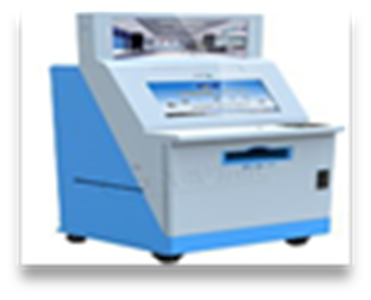
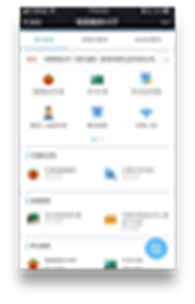
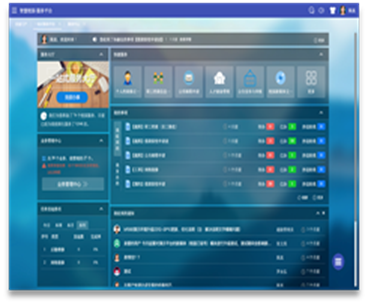
4. Practices
4.1 Beihang University
Project background:
Beihang University has made remarkable achievements in its informationization construction and played a leading role in informationization among Chinese universities. In recent years, Beihang University focuses on the following two aspects during informationization construction. First, school leaders are provided with real-time and comprehensive data on key tasks of various service departments through the integration of campus administration data for campus management. Second, most teachers and students do not deeply feel the convenience of informationization.
Solution overview:
The specific construction contents are as follows:
· Leader cockpit intensively presents the overview of important departments, including personnel, finance, student, teaching, asset, and scientific research.
· Orientation portraits involve undergraduates and postgraduates, comprehensively presenting the freshmen's age, gender, place of origin, constellation, and other information.
· Graduate portrait presents the graduates' performance in school from the dimensions of enrollment, grades, courses, consumption, Internet access, rewards and punishments, and activities.
Solution benefits:
· Leader cockpit enables school leaders to have a real-time and comprehensive understanding of the general situation of each core service unit of the campus and assists leaders in decision-making and management.
· Orientation portrait is convenient for the university to obtain the conditions of freshmen and carry out teaching works according to the characteristics of students.
· Graduate portrait is a precious gift for graduates to preserve a good memory of campus life. After the product was launched, the number of visits exceeded 100,000 within a week, which greatly goes beyond the expectations of the department of student affairs and the publicity department.
· H3C DataEngine platform adopts the converged technical architecture consisting of the offline computing engine, streaming computing engine, and distributed database engine to store and compute massive amounts of data. H3C builds a big data basic platform for the campus. In the future, colleges and universities can develop big data applications continuously, flexibly, and rapidly based on the H3C DataEngine.
2. Shandong University
Project background:
Shandong University (SDU), under the direct jurisdiction of the Ministry of Education, is a key comprehensive university with a long and honorable history, a broad variety of disciplines, strong academic strength and distinctive characteristics, which has had a great influence on both at home and abroad and is listed in the double first-class university program released by the central government of China. SDU has set the informationization construction concept of "teachers and students should be provided with proper services rather than being managed only", and put forward the informationization principle of "teacher-student care, scenario adaptation, service orientation, situation creation, demonstration application, regulatory compliance, and continuous improvement".
In the process of matching the "great" international informationization, the TOGAF standard framework was used for the top-level design of campus management and service informationization. SDU put forward the construction requirements of improving work efficiency for teacher and student services and the requirements of obtaining more details of students' study and life in a more scientific, fine-grained, and objective way through campus big data for big data analysis and decision-making.
Solution overview:
The overall solution mainly includes data resource construction and application service construction. The specific construction content is as follows:
![]() For the data resources, SDU adopts the H3C digital intelligent engine for data integration, data standard management, data development, data quality inspection, and data asset operation in the whole process. It helps complete the campus's existing surveys and related data integration of undergraduate database materials. SDU released Shandong University Data Standard Model and Shandong University Data Warehouse Model.
For the data resources, SDU adopts the H3C digital intelligent engine for data integration, data standard management, data development, data quality inspection, and data asset operation in the whole process. It helps complete the campus's existing surveys and related data integration of undergraduate database materials. SDU released Shandong University Data Standard Model and Shandong University Data Warehouse Model.
![]() For the application services, SDU builds an integrated service platform and smart student affairs system. The smart student affairs system has functions including cartoon analysis, verification of needy students, implicit funding, research and warning.
For the application services, SDU builds an integrated service platform and smart student affairs system. The smart student affairs system has functions including cartoon analysis, verification of needy students, implicit funding, research and warning.
Solution benefits:
A service-oriented data system is constructed to continuously support the innovation of service applications.
![]() The integrated service platform enables online services for teachers and students and improves work efficiency. One-stop online self-service enhances the happiness of teachers and students.
The integrated service platform enables online services for teachers and students and improves work efficiency. One-stop online self-service enhances the happiness of teachers and students.
![]() The smart student affairs system assists teachers in comprehensive analysis and decision-making, as well as controlling and timely interference of abnormal events, achieving service optimization and work efficiency improvement.
The smart student affairs system assists teachers in comprehensive analysis and decision-making, as well as controlling and timely interference of abnormal events, achieving service optimization and work efficiency improvement.
3. China University of Petroleum
Project background:
China University of Petroleum (UPC) is a national key university directly affiliated to the Ministry of Education and a member of the “211 Project” and “985 project innovation platform for well-established disciplines” universities. Since 2017, UPC has been listed among the national plan for Double First-class Construction. UPC is co-constructed by the Ministry of Education, five leading petroleum and petrochemical companies (CNPC, Sinopec, CNOOC, China Shenhua and Yanchang Petroleum) and Shandong Province. Honored as “the cradle of Petroleum talents”, UPC is an important base of high-level talents education for the petroleum and petrochemical industry and has already developed into a multi-disciplinary and well-rounded university focusing on petroleum and engineering.
In recent years, UPC has constantly deepened its informationization construction, and its service system construction of each department has been gradually improved. However, the data of each service system is isolated in each department and the data standards are inconsistent. Teachers and students need to fill out the forms repeatedly, resulting in low efficiency. The data accumulated by the digital campus cannot play to its value.
Solution overview:
H3C smart campus solution provides UPC with full-process data governance services including demand survey, architecture design, data integration, data cleaning, data subject classification, data sharing and exchange, data quality management, and standard management. UPC has achieved the data governance of 24 systems in 10 units and completed the data sharing and exchange of 38 systems in 16 units.
Solution benefits:
Based on the results of data governance, UPC has basically solved the form filling problem, reducing the number of times that teachers and students fill in forms.
UPC has conducted data analysis and exploration for accurate description and evaluation of the level of the teaching staff, which helped them find the shortcomings and deficiencies. In addition, UPC provides policies for the introduction of excellent talents and the training of young teachers, greatly improving the core competency and promoting the Double First-class Construction.
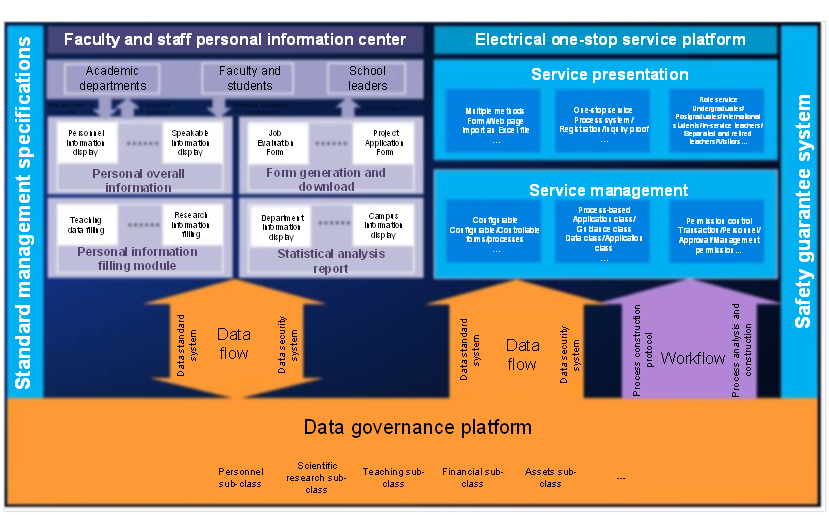
Figure: smart campus data governance platform


